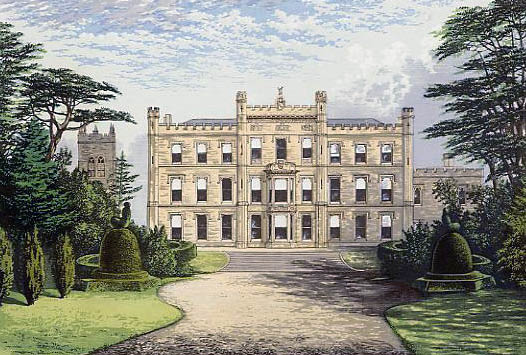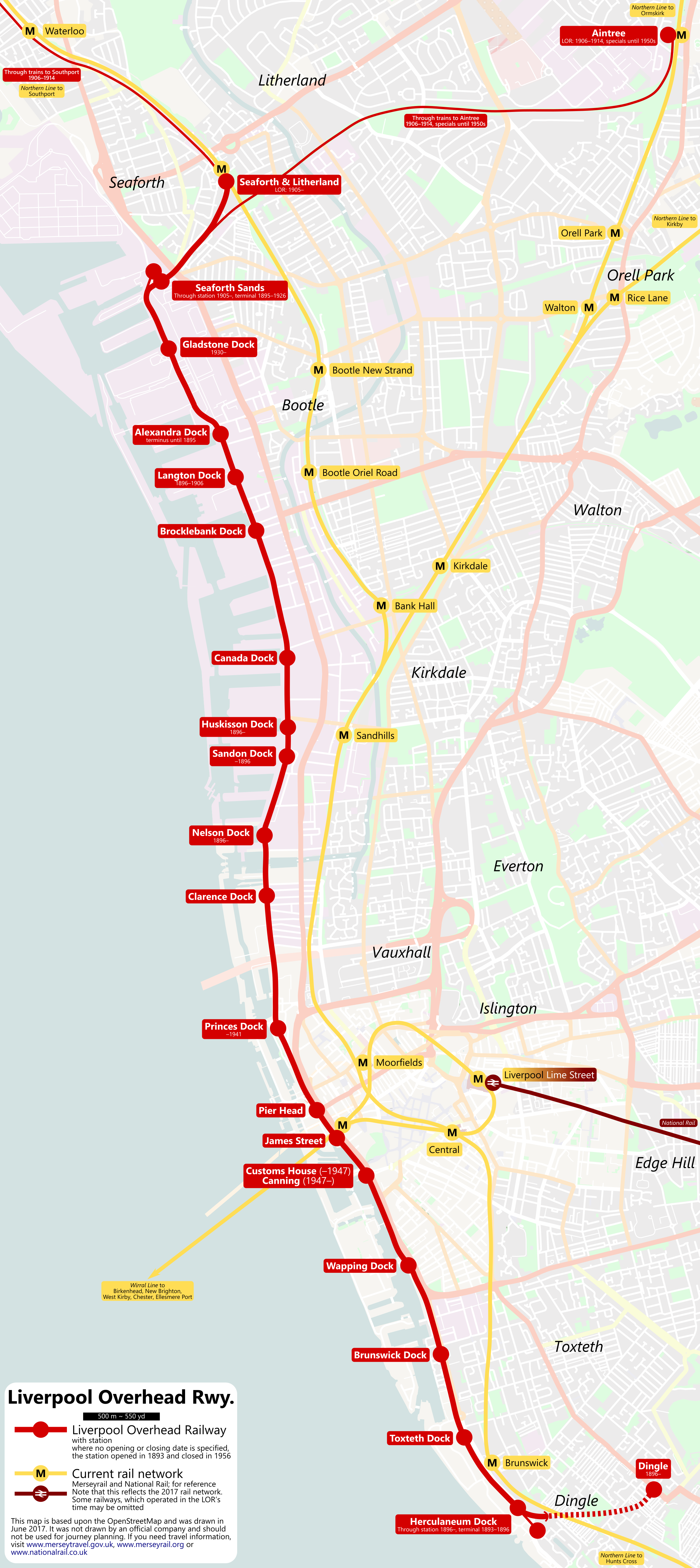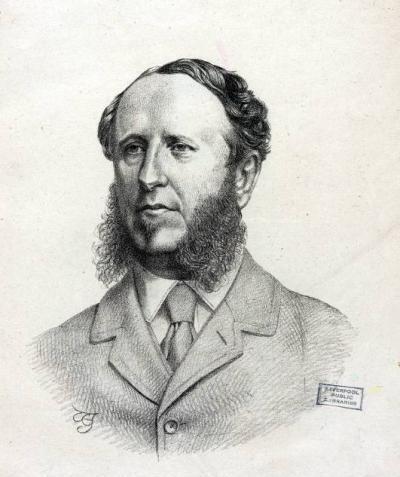|
Harrington Dock
Harrington Dock was a dock on the River Mersey and part of the Port of Liverpool. Situated in the southern dock system, it was connected to Toxteth Dock to the north and Herculaneum Dock to the south. History The first dock on the site was known as Egerton Dock, named after the Dukes of Bridgewater, built between 1837-9. The first dock was small, with a -wide entrance, and intended for river and canal boats moving timber. In 1839, Jesse Hartley and his son were employed by a separate private company to design two further small basins on the site, known as Harrington Dock and Harrington Dry Basin. The name of the dock can be traced to the district of Harrington, intended for a planned overflow town for Liverpool which never came to fruition. The district of Harrington, itself, was named in honour of Lady Isabella Stanhope, daughter of William Stanhope, 2nd Earl of Harrington and wife of Charles Molyneux, 1st Earl of Sefton who owned the former Royal Forest of Toxteth Park. T ... [...More Info...] [...Related Items...] OR: [Wikipedia] [Google] [Baidu] |
Dingle, Liverpool
Dingle (known locally as the Dingle) is an inner city area of Liverpool, Merseyside, England. It is located to the south of the city, bordered by the adjoining districts of Toxteth and Aigburth. At the 2001 Census, the population was recorded at 13,246.It is particularly known for being the Thomas the Tank Engine narrator Ringo Starr History Dingle is an area entirely within the boundaries of the old Toxteth Park. It is named after Dingle Brook (''Dingle'' meaning a wooded valley), which rose at High Park Street and roughly followed Park Road towards the Old Toxteth Chapel, just south of Dingle Lane, and entered the River Mersey at Knott's Hole, which was a narrow bay or inlet next to where the Dingle flowed out to the Mersey. On either side were steep rocky cliffs, with Dingle Point to the south west. In the 1850s the Dingle area was purely rural. Liverpool lay to the north west, but this was an area of large houses, vast gardens, babbling streams and a long beach. It w ... [...More Info...] [...Related Items...] OR: [Wikipedia] [Google] [Baidu] |
William Stanhope, 2nd Earl Of Harrington
General William Stanhope, 2nd Earl of Harrington (18 December 1719 – 1 April 1779) was a British politician and soldier. The son of William Stanhope, 1st Earl of Harrington, he took up a military career and joined the Foot Guards in 1741, and was also returned for Aylesbury. He was wounded at the battle of Fontenoy and shortly thereafter (5 June 1745) was appointed colonel of the Second Troop of Horse Grenadier Guards, an appointment he held for the remainder of his life. He married Lady Caroline FitzRoy (1722–1784), daughter of Charles FitzRoy, 2nd Duke of Grafton, on 11 August 1746. They had seven children: * Lady Caroline Stanhope (11 March 1747 – 9 February 1767), married Kenneth Mackenzie, 1st Earl of Seaforth * Lady Isabella Stanhope (c. 1748 – 29 January 1819), married Charles Molyneux, 1st Earl of Sefton * Lady Amelia Stanhope (24 May 1749 – 5 September 1780), married Richard Barry, 6th Earl of Barrymore * Charles Stanhope, 3rd Earl of Harrington (1753–18 ... [...More Info...] [...Related Items...] OR: [Wikipedia] [Google] [Baidu] |
Elder Dempster Lines
Elder Dempster Lines was a UK shipping company that traded from 1932 to 2000, but had its origins in the mid-19th century. Founders Alexander Elder Alexander Elder was born in Glasgow in 1834. He was the son of David Elder, who for many years was manager of Robert Napier and Sons, the engine and shipbuilders and the brother of John Elder. Alexander Elder was chief engineer of ''Columbian'', a iron-hulled barque with a 2,116 ihp engine. She was built for the Australian run, and was chartered by France in 1855 as a troop ship for the Crimean War. In 1856 Alexander Elder joined W and H Laird as superintendent engineer for the African Steamship Company. John Dempster John Dempster was born in 1837 in Penport, Thornhill, Dumfriesshire where his father, William Dempster, was builder to the Duke of Buccleuch. The Dempster family moved to Birkenhead in the 1840s and John joined W and H Laird as a clerk in 1851 when he was aged 14. History Elder Dempster and Company Elder ... [...More Info...] [...Related Items...] OR: [Wikipedia] [Google] [Baidu] |
Liverpool Overhead Railway
The Liverpool Overhead Railway (known locally as the Dockers' Umbrella or Ovee) was an overhead railway in Liverpool which operated along the Liverpool Docks and opened in 1893 with lightweight electric multiple units. The railway had a number of world firsts: it was the first electric elevated railway, the first to use automatic signalling, electric colour light signals and electric multiple units, and was home to one of the first passenger escalators at a railway station. It was the second oldest electric metro in the world, being preceded by the 1890 City and South London Railway. Originally spanning from Alexandra Dock to Herculaneum Dock, the railway was extended at both ends over the years of operation, as far south as Dingle and north to Seaforth & Litherland. A number of stations opened and closed during the railway's operation owing to relative popularity and damage, including air bombing during World War II. At its peak almost 20 million people used the railway ever ... [...More Info...] [...Related Items...] OR: [Wikipedia] [Google] [Baidu] |
Herculaneum Dock Railway Station
Herculaneum Dock railway station was the original southern terminus for the Liverpool Overhead Railway. Actually adjacent to Harrington Dock it was named after Herculaneum Dock, a somewhat larger dock beyond the end of the line. It was opened on 6 March 1893 by the Marquis of Salisbury. The station became a carriage shed on 21 December 1896, upon the LOR's southern extension through the cliffside to Dingle Dingle ( Irish: ''An Daingean'' or ''Daingean Uí Chúis'', meaning "fort of Ó Cúis") is a town in County Kerry, Ireland. The only town on the Dingle Peninsula, it sits on the Atlantic coast, about southwest of Tralee and northwest of Kill ... and the subsequent construction of a 'through' station by the same name slightly north of the original. The station closed, along with the rest of the line on 30 December 1956. No evidence of this station remains. References * * External linksHerculaneum railway station at Disused Stations Disused railway statio ... [...More Info...] [...Related Items...] OR: [Wikipedia] [Google] [Baidu] |
Garston And Liverpool Railway
The Garston and Liverpool Railway line ran from the St Helens and Runcorn Gap Railway line at Garston Docks to Brunswick railway station, later to central Liverpool. The company was formed on 17 May 1861 and the line opened on 1 June 1864. Garston Dock station had opened in 1852 as the terminus of the St Helens Canal and Railway Company's line from Warrington. The Act of Parliament for this line had also given the company rights to construct a deepwater dock on the River Mersey at Garston, extending the early St Helens and Runcorn Gap Railway further down the Mersey to a better and less tidal port. The company also aspired to reach Liverpool and the Garston and Liverpool Railway would be the means for this, extending beyond the Garston terminus, and following the Mersey downstream to the North West. Cheshire Lines It was absorbed by the Cheshire Lines Committee (CLC) on 5 July 1865, whose Liverpool to Manchester line joined it at Cressington Junction. Extension to Liverpo ... [...More Info...] [...Related Items...] OR: [Wikipedia] [Google] [Baidu] |
George Fosbery Lyster
George Fosbery Lyster FRSE (1821–1899) succeeded John Hartley as Engineer in Chief to the Mersey Docks and Harbour Board. He is usually referred to as G. F. Lyster. Life He was born on 7 September 1821 at Mount Talbot in County Roscommon in Ireland. He was the third son of Col Anthony Lyster of Lysterfield and Bushey Park (1775-1841), and his wife, Jane Fosbery, the daughter of George Fosbery of Kildimo. He was educated at King William's College on the Isle of Man. He was apprenticed as an engineer under James Meadows Rendel. He was responsible for most of the Birkenhead docks and docks at the north end of the dock estate. He also built the Herculaneum Dock, Harrington Dock and Toxteth Dock. He widened the River Shannon and in the 1850s built the Great Harbour of Refuge at Holyhead. In 1861 he succeeded John Bernard Hartley as Engineer-in-Chief to Liverpool Docks. In 1886 he was elected a Fellow of the Royal Society of Edinburgh. His proposers were Thomas Stevenson, J ... [...More Info...] [...Related Items...] OR: [Wikipedia] [Google] [Baidu] |
South America
South America is a continent entirely in the Western Hemisphere and mostly in the Southern Hemisphere, with a relatively small portion in the Northern Hemisphere at the northern tip of the continent. It can also be described as the southern subregion of a single continent called America. South America is bordered on the west by the Pacific Ocean and on the north and east by the Atlantic Ocean; North America and the Caribbean Sea lie to the northwest. The continent generally includes twelve sovereign states: Argentina, Bolivia, Brazil, Chile, Colombia, Ecuador, Guyana, Paraguay, Peru, Suriname, Uruguay, and Venezuela; two dependent territories: the Falkland Islands and South Georgia and the South Sandwich Islands; and one internal territory: French Guiana. In addition, the ABC islands of the Kingdom of the Netherlands, Ascension Island (dependency of Saint Helena, Ascension and Tristan da Cunha, a British Overseas Territory), Bouvet Island ( dependency of Norway), Pa ... [...More Info...] [...Related Items...] OR: [Wikipedia] [Google] [Baidu] |
Toxteth
Toxteth is an inner-city area of Liverpool in the historic county of Lancashire and the ceremonial county of Merseyside. Toxteth is located to the south of Liverpool city centre, bordered by Aigburth, Canning, Dingle, and Edge Hill. The area was originally part of a royal park and known as Toxteth Park. It remained predominantly rural up until the 18th century. Toxteth was then developed during this time and into the 19th century, mainly as a residential area to accommodate the increasing working-class community centred on Liverpool following the Industrial Revolution. The Welsh Streets in Toxteth were constructed in the mid-19th century to accommodate this demand. Immigration continued into the 20th century, resulting in a significant number of ethnic minority communities in the area. Toxteth was badly hit by economic stagnation and unemployment in the late 1970s, culminating in riots in July 1981. Although attempts have been made to regenerate the area and improve living st ... [...More Info...] [...Related Items...] OR: [Wikipedia] [Google] [Baidu] |
Royal Forest
A royal forest, occasionally known as a kingswood (), is an area of land with different definitions in England, Wales, Scotland and Ireland. The term ''forest'' in the ordinary modern understanding refers to an area of wooded land; however, the original medieval sense was closer to the modern idea of a "preserve" – i.e. land legally set aside for specific purposes such as royal hunting – with less emphasis on its composition. There are also differing and contextual interpretations in Continental Europe derived from the Carolingian and Merovingian legal systems. In Anglo-Saxon England, though the kings were great huntsmen, they never set aside areas declared to be "outside" (Latin ''foris'') the law of the land.H. R. Loyn, ''Anglo-Saxon England and the Norman Conquest'' 2nd ed. 1991:378-82. Historians find no evidence of the Anglo-Saxon monarchs (c. 500 to 1066) creating forests. However, under the Norman kings (after 1066), by royal prerogative forest law was widely applied. ... [...More Info...] [...Related Items...] OR: [Wikipedia] [Google] [Baidu] |
Charles Molyneux, 1st Earl Of Sefton
Charles William Molyneux, 1st Earl of Sefton (11 October 1748 – 31 January 1795) was a Member of Parliament, Member of the Parliament of Great Britain, British Parliament and a member of the peerage of Ireland. He was born on 11 October 1748, the son of Thomas and Mary (née Leverly) Molyneux. Thomas died on 3 September 1756, leaving him the heir to the title 8th Viscount Molyneux, which he inherited at the age of 10 on 30 March 1759 following the death of his uncle, William Molyneux, 7th Viscount Molyneux. He married Isabella Molyneux, Countess of Sefton, Lady Isabella Stanhope, daughter of William Stanhope, 2nd Earl of Harrington, on 27 November 1768. He Conformist, conformed to the Church of England on 5 March 1769, for which he was rewarded the title Earl of Sefton on 30 November 1771 with which the viscountcy was merged. He was elected to the House of Commons of Great Britain, House of Commons in 1771 and represented the Lancashire (UK Parliament constituency), Lancashire ... [...More Info...] [...Related Items...] OR: [Wikipedia] [Google] [Baidu] |
Isabella Molyneux, Countess Of Sefton
Isabella Molyneux, Countess of Sefton, formerly Viscountess Molyneux, (née Lady Isabella Stanhope; c. 1748 – 29 January 1819) was a British peeress and society figure. Biography Lady Isabella Stanhope was the second child of William Stanhope, 2nd Earl of Harrington and Lady Caroline FitzRoy, a daughter of Charles FitzRoy, 2nd Duke of Grafton. She was an older sister of Charles Stanhope, 3rd Earl of Harrington. According to the memoirs of Elizabeth Craven, Baroness Craven, Lady Isabella refused the hand of the Duke of Fitz-James. On 27 November 1768 she married Charles Molyneux, 8th Viscount Molyneux, the future 1st Earl of Sefton in the Peerage of Ireland. On 18 September 1772 Lady Sefton gave birth to a son, the future 2nd Earl of Sefton. She was painted by notable painters including Catherine Read and Thomas Gainsborough, and engraved by the artist James Watson. A portrait of her by Gainsborough was unveiled at the inaugural exhibit of the Royal Academy of Art. A ... [...More Info...] [...Related Items...] OR: [Wikipedia] [Google] [Baidu] |


.jpg)





